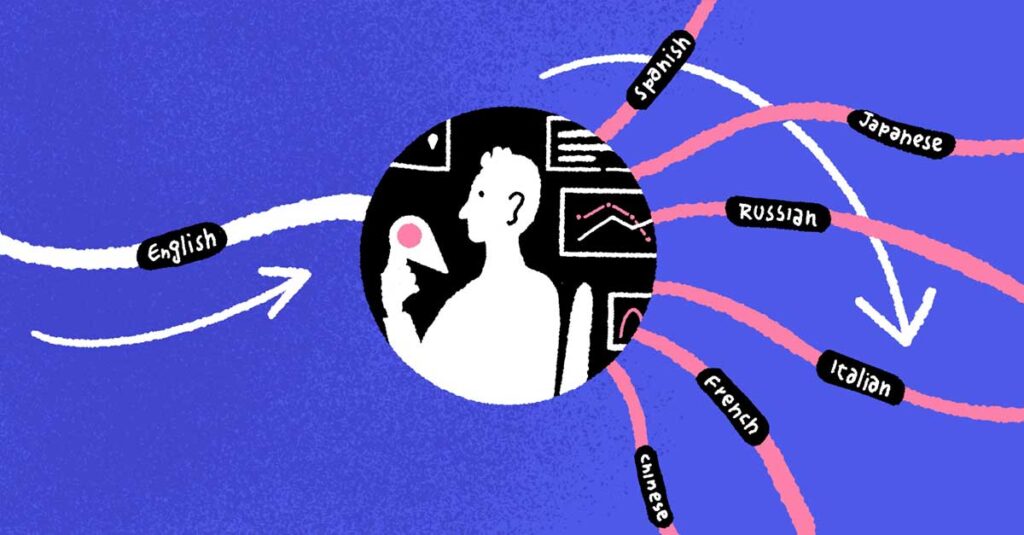The English language is often used as a lingua franca by many businesses, but is this enough as companies continue to expand their global footprints? While it’s estimated that over 60% of online content is in English, only 5% of people around the world are native speakers. The internet may be English-centric, but that doesn’t mean businesses need to be.
This disparity poses an opportunity for companies to differentiate themselves by offering product information and customer service options in their customers’ native languages. In fact, if customers can’t interact with a brand and view its website in their native language, 40% of consumers will not buy from them at all.
Instead of limiting their customer base to English speakers, here’s how companies can expand to support consumers that speak other languages. In this post, we’ll explore what multilingual support is and how you can adopt multilingual customer service at your company.
What is multilingual support?
Multilingual support gives customers an option to interact with a customer service agent in their native language, regardless of where the company is located. While this usually means supporting languages beyond English, companies all around the world are entering new markets and need to communicate with customers in different countries or regions.
While multilingual support is crucial for today’s increasingly global marketplace, it’s still challenging to implement in the real world. Call centers have a notoriously high attrition rate, so it can be difficult to maintain a well-trained team of customer service agents for every language necessary. Language needs can also change quickly, so companies are in a constant battle to get their staffing aligned with demand. Luckily, there are ways to adopt multilingual customer support without relying solely on native speakers.
Ways to adopt multilingual customer support
Nearly every company today understands the value of multilingual support, yet the idea of implementing multichannel customer service across a variety of languages at scale can be overwhelming. Many multilingual service attempts involve a mixture of native speakers, outsourcing, and translation tools, but these approaches are disjointed and make it more difficult for customer service departments to offer in-depth knowledge about the company’s products or services.
Instead, augmented machine translation could be a better option for streamlining language use not only across customer service channels but also by sales, marketing, and other areas of the business. By keeping “humans in the loop” to verify and improve the accuracy of translations, companies can more effectively communicate with customers in nearly any language.
At Unbabel, we call this new unified approach to operationalizing language across the organization Language Operations (LangOps). Here’s how LangOps can streamline multilingual customer service across several channels.
Using augmented machine translation, you can scale your existing email support teams to handle customer inquiries across a wide range of languages. Not only can you support languages that get low volume, but you can also more cost-efficiently support languages in which it’s expensive to hire dedicated native speakers.
An effective LangOps platform can easily integrate with your agents’ existing workflows, whether they use Zendesk, Helpshift, or another customer service platform. This ensures you can prioritize hiring customer service agents for domain expertise rather than language skills.
Live Chat
With LangOps, you’re able to implement live chat so that human agents can get real-time translations of customer inquiries, and have their responses translated back into the customers’ native languages. In many cases, you can also use automated chatbots to handle situations eu where human intervention isn’t necessary, which can relieve some of the burden for your customer service agents.
Unbabel’s Multilingual AI Agent Assistants (MAIA) project aims to overcome the limitations of traditional machine translation solutions by providing more context-aware translations and helpful suggestions to agents that can increase customer satisfaction. That way, you can seamlessly scale your live chat for multilingual customer support.
Help Center
82% of today’s consumers are willing to use self-service options because they can find solutions to their issues immediately without waiting for a customer service agent to respond. Similar to an automated chatbot, a multilingual help center or frequently asked questions (FAQ) resource allows you to scale your support efforts without needing additional agents.
A LangOps platform can help you publish a highly localized help center that empowers customers to solve problems on their own using their native language. For example, Unbabel uses a combination of machine translation and human editors to ensure every piece of content feels authentic and resonates with your customers.
Become language-agnostic with Unbabel
For today’s global companies, customer service is just the beginning. Adopting a LangOps platform like Unbabel can shift your company from using native language agents for support towards adopting a truly multilingual approach across all business functions. That means language can become a strategic asset rather than a barrier to global operations.












